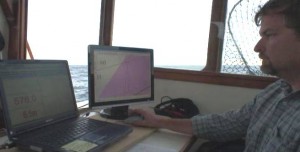Trajan
The Sinking and Discovery of A 19th Century Lime Carrier
On December 6th 2008 the discovery and identification of the shipwreck Trajan in Newport Harbor was the culmination of luck, perseverance and research by Divers/Maritime Historians John Stanford and Mark Munro.

Photo# KN-10867, painting in the U.S. Navel Academy Museum collection.
The Trajan was a Bark rigged sailing vessel and took her name from the Roman Emperor Trajan. She was built in 1856 at the yard of H. Merrian in Rockland Maine, had a length of 125′, a beam of 29′ 6″ and a draft of 13′. From 1856 to 1864 she made several passages between New York, Cuba, and England. By 1867 she was engaged in the Rockland Lime Trade under the command of Captain W. Sleeper. At the time of the Trajan’s loss, August 17, 1867, she was on a voyage from Rockland Maine to New Orleans carrying a cargo of lime. Lime was a dangerous cargo: if it got wet, a chemical reaction created heat and sometimes caused the schooner to catch fire. This was to be Trajan’s undoing.
On September 27, 2008 Munro and Stanford conducted a Side Scan Sonar and Magnetometer Survey in the area where extensive research indicated the Trajan shipwreck should be located.

On the fist side scan sonar pass a large prominent target was observed with the dimensions from the sonogram consistent with what might be expected if it were the Trajan. During post processing it was also noted that there was a significant magnetometer reading associated with this target.
Not wanting to wait until the spring to investigate this target they decided to plan a winter time exploratory dive. On December 5th 2008 they motored to the site in Stanford’s AVON and using a depth recorder located a rise on the bottom at the predicted location of the target. The two then anchored the boat over the site. After donning they’re dive gear and descending to the bottom they were greeted by a large mound of concreted Lime. Stanford and Munro then knew that they had indeed found the long lost remains of the Trajan.
